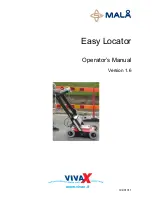
INTERFERENCE
Signals from an interfering radio station may be eliminated or at
least minimized by either of the following methods;
(1) Turn "Station Selector 2" either to the right or left, by
approximately ¾ inch to 1 inch if the selector is at upper part
of scale, or ¼ to ½ inch if at lower part, to find another
position of this control where the desired station will be again
heard. The setting of "Station Selector 2" nearer the left end of
the scale is technically called the "lower wavelength peak" and
the other the "upper wavelength peak". Two settings of this
nature will be found for all broadcast stations, and the separa-
tion between them becomes greater and greater for the higher
end of the scale,
i. e.,
nearer the right hand end. It is
recommended that "Station Selector 2" be consistently set on
the "upper peak" in the usual manipulation of the set. When
interference is encountered, shift to the "lower peak" and use
whichever one at which minimum interference occurs.
(2) Rotate the loop of the Radiola 26. For every transmitting
station, there are two positions at which the signal strength
will rise to a maximum, and two others at right angles where it
is at a minimum. Rotate the loop until best results are secured,
trying to locate the position of the loop where the interference
does not come in, but the desired signals do.
CALIBRATION
To enable the most satisfactory service to be obtained from tlie Radiola 26,
it is desirable to be able to turn to any broadcasting station at will. This can be
done if the station is operating and if transmission conditions are such that the
signal intensity is enough to be received and if the proper adjustments
are known. The first two conditions are ones over which the listener has no
control. To facilitate the proper adjustment, Radiola 26 is furnished with a
"Radiola Calibration" card, ruled with vertical columns with spaces for
Wavelength, Frequency, Call-Letters and Settings of "Station Selectors".
Whenever a station is heard, write down the call-letters and the settings of the
"Station Selectors" in the proper columns. Then the settings can be
duplicated when desired. Since there are two settings of "Station Selector 2"
for every one of "Station Selector
1", it is suggested that only the
(13)







































